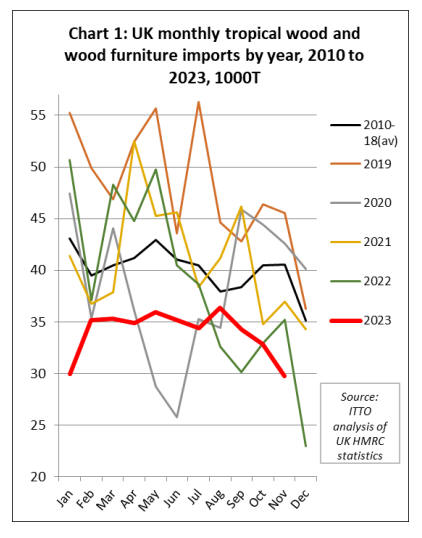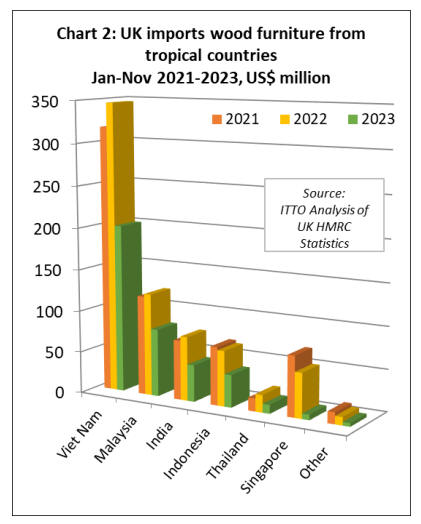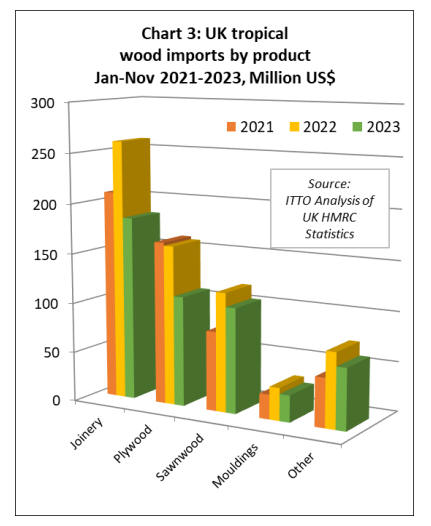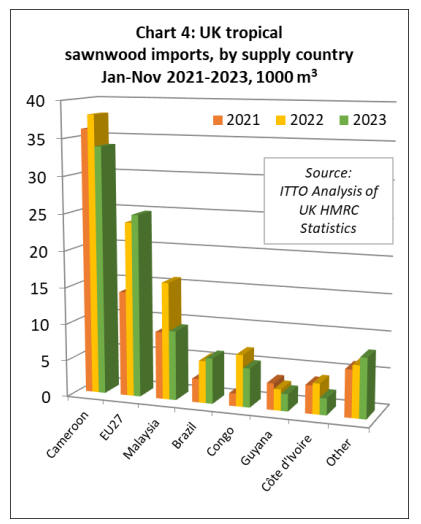|
Report from
Europe
UK tropical wood and wooden furniture imports 30%
below long-term average
The trajectory of UK imports of tropical wood products
continues sharply downwards. In fact, the latest trade data
shows that imports in the closing months of 2023 were
heading towards an all-time low. In the January to
November period last year, the UK imported tropical
wood and wooden furnitureproducts with total value of
US$874 million, 35% less than the same period the
previous year. In quantity terms, the UK imported 374,200
tonnes of these products during the eleven-month period,
15% less than the same period in 2022.
These are very low figures, in tonnage terms the lowest
level of UK tropical wood products imports for an eleven-
month period ever recorded, or at least since the 1980s and
probably well before then. It is 7% below the previous
record low which came in the first eleven months of 2013
at the end of one of the longest periods of economic
stagnation on record in the UK. It is 10% less than
recorded in the first eleven months of 2020 when the
country came briefly to a complete standstill at the start of
the COVID pandemic.
The latest monthly data shows that the total tonnage of UK
imports of tropical wood and wooden furniturefell to an
extreme low of only 22,000 tonnes in December 2022
before crawling back to 36,000 tonnes in August 2023.
Imports then began to slide again, falling below 30,000
tonnes in November last year. That is around one third less
than the long-term average for that time of year (Chart 1).

The backdrop to these historically low import levels is a
continuing slow-moving economy and weak consumer
confidence. The UK economy fared better than forecast in
2023, with KPMG estimating GDP increased 0.5% rather
than contracting the 1% forecast earlier.
KPMG now predicts UK growth in 2024 will hover
around the same figure and only reach 1% in 2025.
The GfK Consumer Confidence indicator for the UK, after
hitting an all-time low of nearly -50 in the second half of
2022, did rise last year but remains in negative territory
which means that most respondents are still pessimistic
about the economy. The index was at -19 in January this
year, up from -22 in December and the third consecutive
month-on-month increase.
The persistent gloomy mood is linked to the Bank of
England maintaining interest rates at 5.25% for longer
than hoped in response to stubbornly high inflation.
Predictions are that the first 2024 interest rate cut of 0.25%
won’t be until August, with a second to 4.75% in
November.
Key for the hardwood and wider timber sector, of course,
are forecasts for the impacts of a sluggish economy on
construction. In its Winter Forecast, published January,
the Construction Products Association predicts the
industry’s output will contract 2.1% this year due to falls
in private housing new build and repair, maintenance, and
improvement – the largest construction sectors.
One hardwood importer interviewed by the ITTO
Correspondent earlier this month observed that “in the
current economic environment, customers are cautious.
They’re taking more time over finalising projects, or
delaying them, and an upcoming election creates more
uncertainty.”
UK import value of tropical wooden furniture down
45%
Of all wood products imported into the UK from the
tropics, wooden furniture declined the most last year. The
UK imported US$386 million of tropical wooden furniture
products in the first eleven months of 2023, which is 45%
less than the same period in 2022. In quantity terms,
wooden furniture imports were 106,200 tonnes during the
eleven-month period, 26% less than the same period in
2022.
In the first eleven months of 2023 compared to the same
period in 2022, UK import value of wooden furniture from
Vietnam was down 42% to US$201 million, Malaysia was
down 34% to US$81 million, India was down 43% to
US$44 million, Indonesia was down 41% to US$39
million, Thailand was down 49% to US$11 million, and
Singapore was down 88% to US$6.5 million (Chart 2).

Across the board decline in value of all tropical wood
product imports
Total UK import value of all tropical wood products in
Chapter 44 of the Harmonised System (HS) of product
codes was US$488 million between January and
November last year, 25% less than the same period in
2022. In quantity terms imports decreased 10% to 268,000
tonnes during the period.

Compared to the first eleven months of 2022, UK import
value of tropical joinery products decreased 29% to
US$184 million, import value of tropical plywood
decreased 31% to US$110 million, import value of
tropical sawnwood decreased 12% to US$105 million, and
import value of tropical mouldings/decking decreased
18% to US$27 million (Chart 3 above).
UK switches to indirect imports of tropical sawnwood
UK imports of tropical sawnwood were 92,346 cu.m in the
first eleven months of last year, 12% less than the same
period in 2022. Although UK imports of this commodity
held up reasonably well compared to other tropical
products in 2023, a larger share was sourced indirectly
from the EU rather than direct from the tropics (Chart 4).
The large majority of sawnwood sourced directly from the
tropics by UK importers now comes from Cameroon. UK
imports of tropical sawnwood from Cameroon were
33,800 cu.m in the first eleven months of 2023, 11% less
than the relatively high level in the same period in 2022.
UK tropical sawnwood imports from Malaysia, which
revived to some extent in 2022 after many years of
decline, fell by 41% in the first eleven months of 2023 to
just 9,500 cu.m. UK imports of tropical sawnwood from
Brazil were 6,200 cu.m in the first eleven months of 2023,
a gain of 8% compared to the same period in 2022.
Imports from all other leading tropical supply countries
declined including Republic of Congo (-25% to 5,300
cu.m), Guyana (-19% to 2,300 cu.m), and Cote d’Ivoire (-
45% to 2,300 cu.m).
Indirect UK imports of tropical sawnwood via the EU
were up last year despite the economic slowdown and
Brexit disruption, increasing 5% to 24,900 cu.m in the first
eleven months. To some extent, UK’s continuing
dependence on indirect imports of tropical sawnwood
from the EU is due to a shortage of kiln drying space in
African supply countries combined with lack of any
hardwood kiln drying capacity in the UK.

UK imports of tropical hardwood mouldings/decking fell
12% in the first eleven months of 2023 to 9,670 tonnes.
Imports of 3,100 tonnes from Indonesia were 30% less
than the same period in 2022.
Imports from Malaysia totalling 2,400 tonnes were down
13% during the same period. Imports of this commodity
group from Brazil were recorded just over 400 tonnes in
the first eleven months of 2023, 76% less than the same
period the previous year. In contrast, imports of
decking/mouldings increased three-fold from both the
Netherlands (to 2,200 tonnes) and Vietnam (to 750 tonnes)
(Chart 5).

Hardwood traders comment on “limp” UK market
Interviews with sawn hardwood traders in the UK by the
ITTO Correspondent sum up the prevailing market mood
as one of uncertainty and caution. One UK hardwood
importer-distributor described the market going into 2024
as ‘limp’. Another commented that there is plenty of stock
on the ground and no significant shortages. Sales volumes
were consequently down and margins ‘a bit squeezed’.
An importer-distributor said it’s been more a case of
managing the market rather than developing it. Forward
ordering is down and, freight rates are back on the rise.
“Generally, there’s no great consideration being given to
forward price in a quiet and nervous market,” they said.
They thought high mortgage rates were less an issue in the
hardwood market, given it is less dependent on new build.
“But customer confidence is an issue generally, with
people holding back on spending more widely, leading to
this slowdown.”
An importer felt that where continuing relatively high
interest rates were also impacting businesses was in
managing day-to-day trading. “We’re in a strong cash
position, but companies borrowing to buy stock must be
finding business more painful,” they said. They added that
their prime customer sector, joinery, had slowed. “Joinery
businesses are reporting volumes down and staircase
producers, in particular, are cooler due to projects being
delayed,” they said. African prices are reported to be
generally stable, although with iroko in tight supply and
firming and sapele, of which one importer remarked there
was plenty available, ‘tending towards softening’.
In TTJ’s recent tropical wood focus, one large tropical
supply company with operations in Africa and Latin
America said that in the slower global hardwood market,
they had cut back on African secondary tropical species. A
UK importer reported the same, although another said
lesser-known species still weren’t figuring highly in the
UK in any market conditions. “Despite environmental
arguments for using them, to take supply stress off more
widely used species and make sustainable forest
management more economically viable, they’re not part of
the customer conversation,” they said.
A project supported by the ATIBT is undertaking life
cycle assessment of tropical timber value added goods to
develop environmental product declarations (EPDs).
Called Dryades, the aim is to increase their appeal in
increasingly environmentally focused consumer markets.
And a UK importer said more of their African suppliers
were now providing EPDs. “It’s suppliers of lumber,
including sapele and utile, as well as engineered wood
products,” they said. “For most customers it’s probably a
nice to have rather than a must. But larger buyers like it
for corporate social responsibility reasons.”
The key topic raised with regards Asian hardwoods is
freight rate resurgence. The latest Drewry World
Container Index of $3,786 per 40ft container compares to
a low of $1,342 in October last year. While the index is
still well below the record of $10,377 set in September
2021 during the pandemic, it is 167% more than the
average 2019 (pre-pandemic) rates of $1,420. “And with
the Suez situation, plus some opportunism on the part of
shipping countries, rates are expected to increase further,”
said an importer-distributor.
Looking at North American hardwood supply, an
importer-distributor said that they had seen prices recently
‘firming modestly across the board’. The outlier was white
oak, which had jumped 10-15% in the last three months.
Some feel upward price pressure on the species may
continue.
Demand from the US barrel stave industry remains robust,
and, while Deloitte predicts just a modest rise in house
building, the Dodge Construction Network is forecasting
an overall increase in US construction starts of 7% in
2024. At the same time the US Federal Buy Clean
Initiative, says Deloitte, should underpin specification of
lower carbon construction materials, including timber.
Also expected to keep US hardwood prices firm, said an
importer, is ‘a lack of available logs going through the
system’.
“There are predictions of further consolidation among US
mills too, which could push up prices,” said an importer-
distributor. They attributed this continuing concentration
of the sector in part to generational issues. “It seems to be
small to medium size mills not having succession plans or
exit strategies,” they said. “The market was very turbulent
for the last 18 months, so it’s not easy to enter with
confidence.”
European oak prices and supply, say hardwood traders, do
not seem to have been significantly affected by European
embargoes on Russian and Belarusian imports, or supply
cutbacks from Ukraine due to the war. “There have been
no impacts that we’ve seen,” said an importer-distributor.
“If our [European oak] suppliers have, they’re not saying.”
“The European oak business remains generally stable,”
said another importer. “And we’ve heard rumours that
there is also still pre-conflict Russian timber on the
market. Where the war has had greatest impact is on larch,
but rather than increasing demand for more expensive
hardwoods and clears, customers are opting instead for
[treated] white wood.”
Demand for both temperate and tropical engineered wood
products is said to be increasing in the UK. One importer
distributor described their performance as positive,
although they still required ‘persistence, [more] product
knowledge and market identity.
Another said they were seeing engineered growth across
species, including in US white oak, European oak,
Uruguayan grandis and sapele. In the latter, however, they
felt African producers were over pricing. “We’re buying
our engineered sapele from Malaysian suppliers. They’re
still competitive despite shipping the lumber across the
world,” they said.
Modified wood is also in the ascendant again, thanks
largely to improvement in Accoya supply after expansion
work at the Arnhem production facility reduced output.
“We’re not back to previous peaks, but we’ve doubled
monthly sales compared to the low point during the
expansion,” said an importer-distributor.
On the UK hardwood sector’s radar too, of course, is the
EU Deforestation Regulation, which comes in for large
EU businesses at the end of this year and six months later
for SMEs. It covers all timber placed on the EU market
and EU exports, stipulating that operators and larger
traders undertake due diligence to ensure no goods are
implicated in deforestation and forest degradation.
That includes providing geolocation coordinates for the
individual “real estate properties” from which wood may
have been derived.
The general view is that there are still a lot of unknowns
about the EUDR and how it will impact on the UK. One
importer commented: “It will be interesting to see how the
UK navigates the volume of West African hardwood
which enters the market via trade kilns in the EU.”
Another raised the issue of Northern Ireland, which
remains in the EU single market, and whether timber
shipped there from Great Britain and not destined for
transhipment to the Irish Republic would need EUDR
conformance information.
Importers are also following developments in the US.
While the UK is now the largest European export market
for American hardwood, large volumes are also destined
for the EU, particularly to Italy, Germany, and Spain.
However, at least 70% of US hardwood supply derives
from private non-industrial forest owners, of which there
are over nine million with average holding size of no more
than 9 hectares.
A typical hardwood mill will purchase logs from several
hundred non-industrial owners each year and a completely
different set of small owners in the following, each
supplying a varied mix of species and grades in very small
quantities. This wood must pass through several stages of
aggregation, sorting, mixing, and processing to build
consignments of specific species, size, and grade to the EU
market. This makes provision of geolocation coordinates
for the origin of their timber particularly challenging.
Consequently, the American Hardwood Export Council
(AHEC) is working on a new procedure linking
comprehensive legality risk assessment with regular AI-
based analysis of satellite images and a chain of custody
standard to verify that US hardwood derives from
deforestation-free geolocations.
At present AHEC is only saying this is ‘potentially’ a
solution for EUDR conformance, given that EU regulators
will have to accept the approach. But, adds AHEC, it will
also enable US hardwood suppliers to make a ‘global
legality and deforestation-free claim’.
The general view of the UK hardwood sector is that 2024
will be challenging, with multiple significant issues to
keep tabs on. “Interest rates are still 5.25%, household
budgets are stretched, and government spend is down
across the board,” said one importer-distributor, “so we
need to be careful with inventory. Speculation can wait for
another day.”
Another agreed, saying the number of unknowns ahead
made forecasting tough, but with the high cost of money
and tight margins, smaller companies particularly could
find life challenging.
“We’ve done our budgets for 2024/2025 and see key
strategies for the year ahead as, of course, as maintaining
service levels, but also nipping at competitors’ market
share,” they said.
“We won’t be jumping out the window but nor putting out
the bunting.”
German forest industry takes issue with EUDR
In an open letter to the German Federal Government, the
German forestry and wood products sector argue that the
“the impending bureaucratic hurdles and high technical
requirements” of the EU Deforestation Regulation
(EUDR) “will prevent all market participants from
maintaining free access to the markets and small private
forest owners will be left behind”. They also complain that
“the documentation, digitisation and administrative effort
for large and medium-sized companies in the forestry and
wood industry will be disproportionately high in relation
to the benefit of the regulation”.
The challenge to the EUDR came in an open letter issued
by the Plattform Forst und Holz (PFH - Forest & Wood
Platform) on 26 January to the German Federal
Government “regarding the implementation of the EU
Deforestation Regulation” calling for “an unbureaucratic
and practical implementation of the Regulatory
Framework in German State, Private, and Municipal
Forests, as well as in the Wood Industry Operations”.
PFH is collaboration between the German Forestry
Council (DFWR) and the German Wood Industry Council
(DHWR) which represents the “common interests of the
Forest and Wood cluster as a wood industry chain from
the forest to the end product”. The letter notes that “with
an annual total turnover of €181 billion, 128,000
companies, and 1.1 million employees, wood-based value
creation plays a significant role in the economic strength
and employment in Germany, particularly in rural areas”.
The letter was addressed to three Ministers of the German
Federal government, respectively: Cem Özdemir, Minister
for Food and Agriculture; Steffi Lemke, Minister for
Environment, Nature Conservation and Nuclear Safety;
and Robert Habeck, Minister for Economic Cooperation
and Development. It was copied to all Members of the
Federal Government, Members of the German Bundestag,
and German Members of the European Parliament.
While welcoming in principle the EU's efforts to reduce
global deforestation to preserve biodiversity and achieve
climate goals, the PFH notes that “the practical
implementation of the EU regulation against deforestation,
especially the implementation and compliance with due
diligence, and the preparation of due diligence
declarations, will incur significant bureaucratic and
economic expenses.
This is particularly true for small private forests, forestry
associations, and the wood industry, as many of the
required pieces of information are not currently collected
and/or not available in digitized form”.
On the question of EUDR’s “proportionality”, the PFH
observes that “a comprehensive implementation of the
EUDR in member states with low deforestation risks will
not improve the global deforestation situation, as the
problem of illegal deforestation does not exist in these
member states”.
PFH goes on to suggest that “To maintain proportionality,
a differentiated implementation of the regulation should be
pursued, taking into account the deforestation risk of each
member state. An undifferentiated implementation of the
regulation leads to significant additional bureaucratic
overhead, unnecessary and avoidable concerning wood
production due to existing forest laws, widespread
functioning forestry administrations, and a high level of
voluntary certification in Germany”.
PFH suggest that “based on the current knowledge, a
rather bureaucratic and impractical implementation of the
regulation at the national level is emerging” and goes on to
formulate various of “points of criticism”. The first is that
in Germany the “protection of forests against damage and
illegal logging is already fully covered by established
control mechanisms”.
The second is that “compliance with the EUDR will fail
due to the lack of IT capabilities of smaller companies and
individual forest owners, thus excluding them from the
market”. PFH comment that “There are numerous forest
owners, especially in small private forests, and affected
wood companies that cannot currently implement the
requirements of the EUDR due to a lack of IT capabilities.
As a result, they will lose market access at the end of the
transition period. This will lead to the discontinuation of
the management of these forest areas”.
A third “point of criticism” is that “Contrary to the efforts
of the German government to reduce bureaucracy, the
national implementation of the EUDR will result in an
enormous bureaucratic burden. This affects not only forest
owners but also the federal states and the federal
government itself.
The effort required for data collection and entry, the
necessary human resources for documentation and control,
as well as the overall effort for the implementation of the
regulation, are not necessary in Germany and other
member states with a low deforestation risk. Additional
measures in these countries do not improve the global
deforestation situation”.
Another “point of criticism” is that the “trial run of
companies using the EU Information System (IS) reveals
significant deficiencies in technical implementation.
Several companies in the forestry and wood industry
participating in the test phase of the EU Information
System (IS) sent a clear signal: the technical
implementation as envisaged will not be feasible. The
system has major deficiencies in data input, processing
capacity and clarity.
The EUDR will lead to a large number of different raw
material sources in Germany resulting in a significant
number of initial declarations and reference numbers.
Only a fully automatic interface will be able to handle the
expected workload, especially for large companies”.
The PFH conclude “We urgently call on the Federal
Ministry of Food and Agriculture to advocate for a
differentiated implementation of the EUDR, avoiding
additional bureaucracy, ensuring that no forest owner loses
market access and is overwhelmed and preventing
additional control efforts for the forestry authorities of the
federal states. The practicality of the regulation is
currently not given. In this regard, we refer to similar
statements from other EU member states”.
“A country demonstrating no objections in the last 10
years regarding the main objective of the EUDR, namely
preventing illegal deforestation, should be exempted from
implementing the corresponding processes. In our view,
this ensures the necessary WTO conformity while
avoiding unnecessary bureaucracy and associated costs”,
according to PFH.
To support their proposal, PFH observe that “Germany,
with 11.4 million hectares, is one-third forested and the
wood stock in the country's forests is larger than in any
other European Union (EU) country. For decades, the
forest area in Germany has been steadily increasing,
secured by proven sustainable forest management, existing
federal and state forest laws, and various certification
systems (80% of the forest area is certified).
Normative, legal, and voluntary restrictions exist,
ensuring effective sustainable forestry without
deforestation and forest damage in Germany, thus securing
the provision of ecosystem services in the long term”.
|